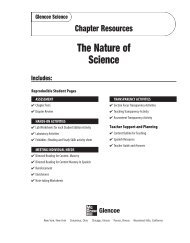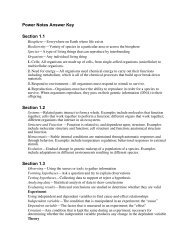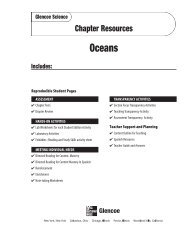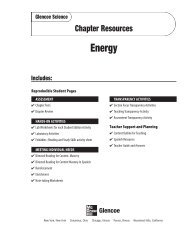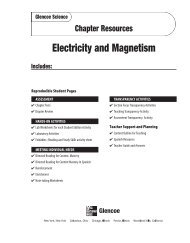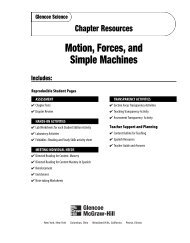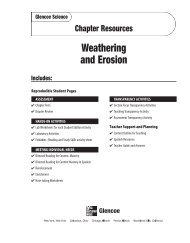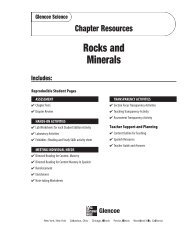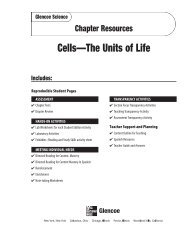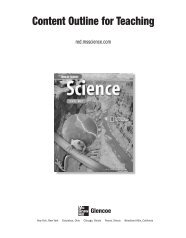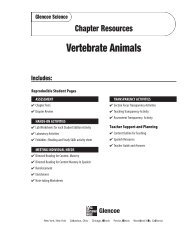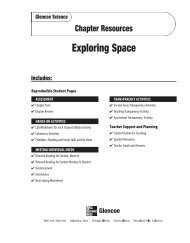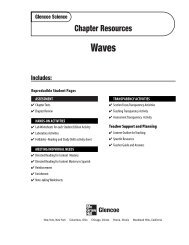Chapter 21 Resource: Ecology
Chapter 21 Resource: Ecology
Chapter 21 Resource: Ecology
- No tags were found...
You also want an ePaper? Increase the reach of your titles
YUMPU automatically turns print PDFs into web optimized ePapers that Google loves.
Teacher Support & PlanningTeacher Guide & Answers (continued)5. Answers should indicate that a food chain isonly part of a food web, which includes more ofthe overlapping relationships in an ecosystem.(6/3)6. The statement is true. Decomposers are all classifiedas consumers because they eat otherorganisms. However, there are consumers thateat live organisms, so they are not decomposers.(5/3)7. Answers will vary, but should refer to significantchanges in one or more biotic or abiotic factorsas a cause of imbalance in an ecosystem. (2/1)III. Applying Skills8. O (1/1)9. F (2/1)10. F (2/1)11. O (5/3)12. O (2/1)13. turtle, plants, insects, bacteria (1/1)14. sand, air, water, temperature, light from lamp(1/1)15. Answers will vary, but may include the size ofthe terrarium, fly population, and amount ofwater. (4/2)16. turtle, flies, bacteria (5/3)17. A bear plays the role of a biotic factor because itis a living organism that interacts with otherfactors in the forest ecosystem. A bear is a memberof the community of forest animals. Twoother roles played by the bear are as a memberof a population and as a consumer. (4/2)Transparency ActivitiesSection Focus Transparency 1 (page 40)Fish FoodTransparency Teaching Tips■ This transparency can be used to introduce theconcept of an ecosystem. Link the living and nonlivingcomponents of an aquarium with the bioticand abiotic factors of an ecosystem. Discuss howthe different parts of an ecosystem interact withone another just as the different parts of anaquarium interact.■ Allow students who have an aquarium at home orwho have worked with a classroom aquarium toshare their experiences setting up, cleaning, andmaintaining the aquarium. Ask: Did one animalever eat another one? Did the water ever becomeunhealthy? What would happen if you forgot tofeed the animals in the aquarium? What wouldhappen if you put the aquarium in a dark closetfor a month?■ The large fish in the freshwater aquarium in thepicture is a discus (Symphysodon sp.). Discus areomnivorous, inhabiting rivers and lakes. Also visibleare cardinal tetras (Paracheirodon axelrodi). Bothspecies are common South American fish.Content Background■ An ecosystem is made up of organisms interactingwith one another and with nonliving factors toform a working unit. An aquarium is a man-madeecosystem on a small scale.■ When keeping an aquarium, water quality andtemperature, tank decorations, diseases, andfeeding are ongoing issues. Water quality is one ofthe most important issues. The water used shouldbe clean and be able to provide oxygen to theinhabitants. Chlorine and other pollutants have tobe removed from water that will be put in afreshwater aquarium. Special chemical drops orfilters can be used for this, or the water can sit fora few days in an open container. Natural andartificial seawater can be used for marine animals.■ Some aquaria are balanced with plants and animals,meaning that no mechanical system of cleaning thetank is needed. Although this balance between plantsand animals is naturally attained in nature, it isvery difficult to reproduce in an aquarium.Answers to Student Worksheet1. Possible answers: fish, plants, snails, algae, and so on.2. Possible answers: gravel, decorations, water, sunlight.3. Possible answers: Animals of the same speciesmate and reproduce. Some eat the plants or mayeat one another. The animals live in the water,hide in the plants and decorations, burrow in thegravel. The plants take in energy from sunlight,live in the water, give off oxygen in the water.Section Focus Transparency 2 (page 41)Can I Live With You?Transparency Teaching Tips■ This transparency can be used to discuss howorganisms interact in a community. Point out thatin some relationships, both organisms benefit butin others one organism is harmed. Ask students tocompare the relationship shown in thephotograph with predation.■ Ask students to think of other examples oforganisms living close together, such as fleas andticks on a dog. Ask: Is one of the organismsharmed by the relationship? Is one helped?Content Background■ The example shown is one of mutualism: asymbiotic relationship in which both organismsbenefit from the relationship and neither isharmed.■ The clown fish lives among the anemone’sstinging tentacles, but is not harmed by them. Thefish is covered with mucus from the anemone,which protects it. Without the mucus, the fish willbe attacked and eaten. Living among the anemone’stentacles protects the fish from other predators.The clown fish in turn acts as a cleaner and protectsthe anemone from anemone-eating fish.Copyright © Glencoe/McGraw-Hill, a division of the McGraw-Hill Companies, Inc.T12<strong>Ecology</strong>




